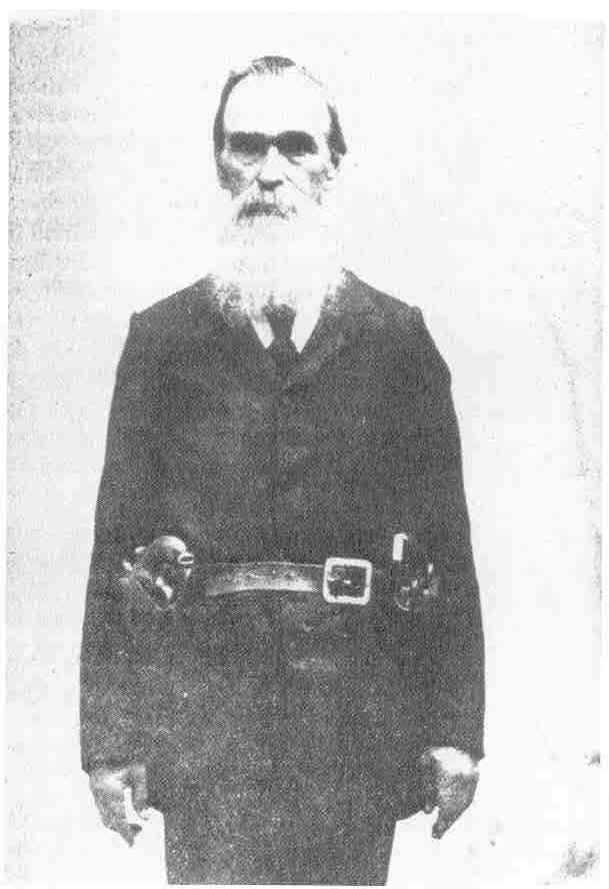Judge Isaac Parker's Hangman
The Story of George Maledon
Before the appointment of a permanent position of hangman for the Court, the U.S. Marshal of the Western District of Arkansas served the purpose. However, there was not a marshal that wanted to do the job. In a book entitled Heck Thomas, Frontier Marshal by Glen Shirley, there is an account by Heck Thomas of a visit with the old Hangman.
George Maledon was a whispy, black-bearded Bavarian who drifted to the southwest before the Civil War. He settled in Ft. Smith where he served as a policeman and deputy sheriff. He was quick as a cat and a crack shot, wearing two pistols in his work. When the Civil War began, he signed up with the First Arkansas Federal Battery. This service to the Union later assisted his employment to the federal court in Ft. Smith. Maledon enjoyed his work in the Ft. Smith prison as a guard.

As times changed and Judge Parker began sentencing more prisoners to the gallows, the U.S. Marshals became more outspoken to Judge Parker about having to "spring the trap". Maledon volunteered to do the job and received $5 a head. Afterward, he was shunned by the community. Saloon keepers, the good people, children, merchants and even the town's shiftless were afraid to associate with the "Prince of Hangmen".
Heck was apparently attracted to the macabre vocation of Maledon. On one occasion, Maledon showed Heck a box of tin types of each prisoner with which he had dealt. Also exhibited was a collection with ropes, leg irons, straps and one rope that had been used in eleven hangings. Maledon commented "It is made of the finest hemp fiber, hand made in St. Louis and treated to keep it from slipping". The rope is originally 1 1/4" in diameter. It is oiled and a 200 pound weight is tied to the end at which time it is stretched and dried to a one inch diameter, the best size for hanging according to Maledon.
Heck asked George why he used that particular knot. The old man seemed pleased to show Heck why he liked the knot. He said "You see, a big knot is necessary to have a humane hanging. If it doesn't break the man's neck when he drops, he strangles. That isn't a pretty sight. He just kicks and twists a lot". He then used Heck to demonstrate the proper way to hang a man. The Knot is put just behind the left ear in the hollow behind the jaw bone. The rest of the rope is draped over the condemned person's head to hold the knot vertical so it will snap the neck when he drops. "It always works for me" George said.
The hangman's job was more than just dropping the trap door. He was also in charge of inspecting the gallows for sound construction. The steps of the gallows must be in good shape. The great beam must be strong enough to handle the weight of three or more men dropping all at once. He oiled the hinges of the trap door so it didn't squeak when it dropped. He also picked the six guards and issued them uniforms and weapons and gave them instructions. He provided a new suit and a coffin to the condemned as well as arranging the burial in Potter's Field for the unclaimed bodies. Early day hangings were witnessed by thousands of people. It often took on a carnival atmosphere. This was stopped by Judge Parker and the Hangman was in charge of issuing the witness passes.
When the time came, the clergymen were in the cells with the prisoners. The U.S. Marshal then entered and read the Death Warrant. The prisoners were led to the gallows and a short religious service was held. Then the noose was placed around the neck. The prisoner was allowed a few final words and the straps were attached around the prisoners hands and legs. The black hood was placed over the head and the knot adjusted by the hangman. The hangman took his place by the bolts. At the given sign, the bolt was pulled and the prisoner dropped. He was left hanging for a half hour. The hangman and his guards removed the body and placed it in the coffin.
On the morning of the three hangings which was Heck Thomas' lesson in hanging, Heck saw that all three heads hung oddly to the left and the bodies never made a twitch. He remembered George Maledon's words about the rope and the knots, "It always works for me."
Dennis Muncrief, October 2001